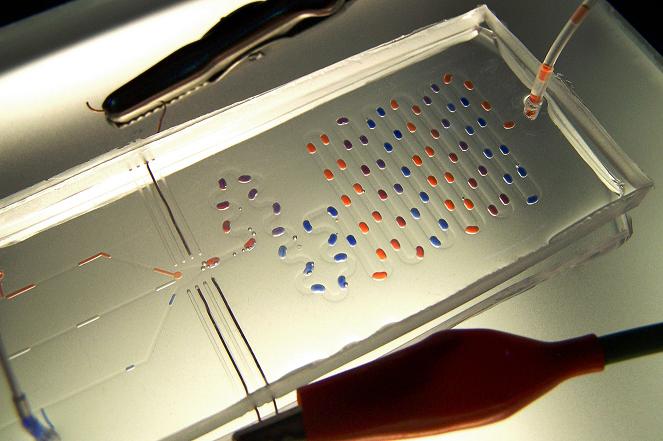Through the use of a microflow system the size of a credit card, developed at the Institute of Physical Chemistry of the Polish Academy of Sciences, tens of thousands of chemical and biochemical experiments can be performed every day. The innovative device has already been tested and proved its advantages in research on the effectiveness of antibiotic mixtures

A group of researchers from the Institute of Physical Chemistry of the Polish Academy of Sciences, led by Piotr Garstecki, has built a micro-flow system that allows streams of droplets containing several solutions to merge. The new system makes it possible to prepare and precisely control the concentrations of micromixtures for a chemical reaction, and works several times faster and in smaller volumes of liquid, than the microtiter plate commonly used in research laboratories today. "The device developed by us makes it possible to perform tens of thousands of biochemical experiments every day," said the researcher. The microlaboratory device may have a significant impact on the way experiments are carried out in the fields of chemical synthesis, medical diagnosis and biotechnology.
The developed microflow system is a tiny response tool the size of a credit card. Chemical reactions take place inside tiny droplets that move along small specially designed channels. The volume of the drops is controlled by a computer and they are usually in the volume of one microliter. The system operates at a rate that allows three drops to be mixed every second. Moreover, instead of using micro-valves, which are complicated to construct, scientists use large, inexpensive valves located outside the device. "Minimizing all the components is simply an uneconomic matter. Taking the valves out of the microsystem makes it possible to develop a simple, cheap and disposable chip. The most important fact is that the chemical reactions themselves are carried out on a micron scale under precisely controlled conditions," notes one of the researchers.
The invention of the researchers from Poland already has the potential to influence the development of several fields in chemistry and medicine, especially in material screening. Today, screening is done using micro-titer flasks - flasks with hundreds of bars that are filled by a robotic device. In this type of research the cost of each and every response reaches three dollars, while the cost of respondents is only about twenty cents; The rest of the cost covers the maintenance of the system and its infrastructure. Since in a typical project to find a new drug the number of compounds being tested may range from several hundred to several million, the costs may reach millions of dollars. "Not only does our microflow system reduce all types of costs, but it also significantly shortens the time required to perform the research," emphasizes the lead researcher.
The innovative microflow system may be particularly important in the discovery of new drugs, especially those that include multiple antibiotic agents. Mixtures of antibiotic substances usually have an increased (synergistic) or decreased (antagonistic) effect, relative to the effect obtained from each of them separately. However, such a reduced effect in the fight against microorganisms is not easily predictable. Detecting this effect requires tedious and lengthy experiments. The innovative device will be able to quickly locate the effective mixtures that can prevent the basic problem in contemporary medicine - the development of drug-resistant bacterial strains.
Tests conducted at the Institute of Physical Chemistry allowed the scientists to demonstrate the activity of the microflow system under conditions simulating the running of a mechanized sifter. Each microdrop was mixed with two microdrops of antibiotic substances - chloramphenicol and tetracycline - and the volume of each of the antibiotic substances was changed in a gradual and controlled manner so that the relative concentration of each of them could be regulated. The drops that have been mixed in the microflow system are left for three hours in order to incubate the bacteria. In the next step, the luminescence intensities emitted from metabolite markers were examined and thus the percentage of active bacterial colonies in each and every one of the drops could be easily determined. The entire process was fully mechanized and showed that the mixture in which the antibiotic substances were in equal proportion was the least effective of all.

One response
First of all - very cool!
Secondly, I really hope that the price of $3 per well will drop significantly because when it comes to a chip like this with, let's say ten thousand wells, that's quite a fortune.
The last thing is skepticism about the final stage of growth: this very small volume can have an effect in itself on growth. If an average bacterium is (say) 0.1 microliter, then a growth environment of 3 microliters can be problematic when it comes to the population. This becomes especially valid in organisms with potentially exponential growth with a fast cycle time (sometimes 20 minutes).
Greetings friends,
Ami Bachar